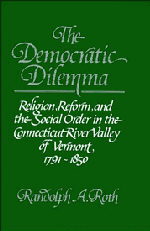 The Democratic Dilemma
The Democratic Dilemma Book contents
- Frontmatter
- Contents
- List of tables and maps
- Acknowledgments
- Introduction
- 1 The revolutionary frontier, 1763–1800
- 2 The failure of the covenanted community and the standing order, 1791–1815
- 3 Religion and reform in the shaping of a new order, 1815–1828
- 4 From an era of promise to pressing times, 1815–1843
- 5 A clamor for reform, 1828–1835
- 6 The great revival, 1827–1843
- 7 A modified order in town life and politics, 1835–1850
- 8 Boosterism, sentiment, free soil, and the preservation of a Christian, reformed republic
- Conclusion: Religion, reform, and the problem of order in the Age of Democratic Revolution
- Appendix A Church records
- Appendix B Types of towns
- Appendix C Occupational groups
- Appendix D Statistical methods
- Notes
- Index
Appendix C - Occupational groups
Published online by Cambridge University Press: 04 August 2010
- Frontmatter
- Contents
- List of tables and maps
- Acknowledgments
- Introduction
- 1 The revolutionary frontier, 1763–1800
- 2 The failure of the covenanted community and the standing order, 1791–1815
- 3 Religion and reform in the shaping of a new order, 1815–1828
- 4 From an era of promise to pressing times, 1815–1843
- 5 A clamor for reform, 1828–1835
- 6 The great revival, 1827–1843
- 7 A modified order in town life and politics, 1835–1850
- 8 Boosterism, sentiment, free soil, and the preservation of a Christian, reformed republic
- Conclusion: Religion, reform, and the problem of order in the Age of Democratic Revolution
- Appendix A Church records
- Appendix B Types of towns
- Appendix C Occupational groups
- Appendix D Statistical methods
- Notes
- Index
Summary
Occupational groups
For the purposes of statistical analysis, this study divides the adult male taxpayers and household heads of the valley into eleven broad occupational groups. These categories were drawn with an eye to classifying male inhabitants according to wealth, economic function, and occupation. Each category encompasses a diverse array of men, but the categories proved sufficient for almost every analysis, although it was necessary in a few instances to divide adult males into narrower occupational groupings.
The basic goals of the classification system were to distinguish self-employed proprietors from salaried and wage-earning employees, and to separate blue-collar workers in agriculture, manufacturing, and day laboring from white-collar workers in the professions, commerce, finance, and government service. An additional aim was to divide proprietors according to the size of their firms, the number of their employees, and the depth of their involvement in the regional economy. Because of the limitations of the economic information that has survived from the early nineteenth century, these goals could not be fully met. Separating white-collar employees from their blue-collar counterparts presented difficulties that were in most cases impossible to overcome.
Adult males were assigned to occupational groups primarily by means of tax lists. These lists, drafted annually by each town's assessors according to the exacting specifications of Vermont's tax laws, itemize real and personal property holdings, record the amount of money each individual had lent at interest or invested in bank and insurance company stock, and show the tax paid by self-employed professionals, merchants, and manufacturers on the basis of the volume of their business.
- Type
- Chapter
- Information
- The Democratic DilemmaReligion, Reform, and the Social Order in the Connecticut River Valley of Vermont, 1791–1850, pp. 319 - 322Publisher: Cambridge University PressPrint publication year: 1987


